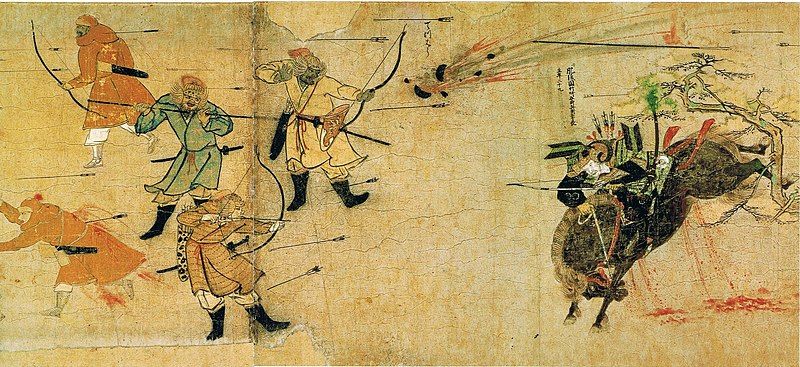You are using an out of date browser. It may not display this or other websites correctly.
You should upgrade or use an alternative browser.
You should upgrade or use an alternative browser.
Yoji juku go Four Kanji Expressions
- Thread starter Meitetsu
- Start date
Sanke
Green Belt
Ok? Did you have a question or topic to discuss on this? This is really just a statement of an idea within JSA.
Did you want to discuss the ideas of distancing within swordsmanship perhaps?
Sanke on the move.
Did you want to discuss the ideas of distancing within swordsmanship perhaps?
Sanke on the move.
Xue Sheng
All weight is underside
Google Translate can be fun..... not as much fun as Bablefish...but fun
一足一刀の間合い
Reach pair of cut with a sword
一足一刀の間合い
Reach pair of cut with a sword
Sanke
Green Belt
Google Translate can be fun..... not as much fun as Bablefish...but fun
一足一刀の間合い
Reach pair of cut with a sword
Yeah, google translate comes up with some interesting things
From my understanding, it's also known as 'the distance of one inch'.
Basically standing facing your enemy with the tips of the swords just touching.
Any closer and you get to 'the distance of blood' (don't know the Japanese of the top of my head) and someone's gonna come out with a few less liters of blood.
Out of curiosity, Xue, are there similar ideas in CMA weapons work? I assume there'd be some shared ideas there
Sanke on the move.
Xue Sheng
All weight is underside
Yeah, google translate comes up with some interesting things
From my understanding, it's also known as 'the distance of one inch'.
Basically standing facing your enemy with the tips of the swords just touching.
Any closer and you get to 'the distance of blood' (don't know the Japanese of the top of my head) and someone's gonna come out with a few less liters of blood.
Out of curiosity, Xue, are there similar ideas in CMA weapons work? I assume there'd be some shared ideas there
Sanke on the move.
Really can't answer that one, I have done a lot of weapons forms but very little application when it comes to swords. However from what little I know the Japanese view of a sword fight is a bit different than the Chinese view. However the basic idea is someone is gonna die when the swords come out. And some of the sword work is not necessarily sword against sword, there are a lot of moves in Taiji dao that are geared towards fighting a guy with a spear, but that could be used against another Dao as well. I think it is possible that the Chinese battlefield was a little more chaotic and a lot more crowded than the Japanese battlefield.
Meitetsu
Yellow Belt
- Joined
- Sep 7, 2012
- Messages
- 55
- Reaction score
- 3
- Thread Starter
- #6
No defined reason, it was just on my mind and wanted to see if anyone was familiar with the phrase or had any comments.Ok? Did you have a question or topic to discuss on this? This is really just a statement of an idea within JSA.
Did you want to discuss the ideas of distancing within swordsmanship perhaps?
As we train with various weapons the Issoku Itoh no ma-ai applies to the distance you need to achieve in order to attack.
The Japanese did have a tradition of fighting one to one, which is why they almost got done in by the Mongols in the year....whenever they attacked.
Meitetsu
Yellow Belt
- Joined
- Sep 7, 2012
- Messages
- 55
- Reaction score
- 3
- Thread Starter
- #7
Here is the picture I was thinking of. The Samurai is going man to man and the Mongol forces are launching arrows in a group. There are also some sort of clay jar hand grenade type things being used.

"The Mongol invasions of Japan (元寇 Genkō[SUP]?[/SUP]) of 1274 and 1281 were major military efforts undertaken by Kublai Khan to conquer the Japanese islands after the submission of Goryeo (Korea) to vassaldom. Despite their ultimate failure, the invasion attempts are of macrohistorical importance, because they set a limit on Mongol expansion, and rank as nation-defining events in Japanese history. The Japanese were successful, in part because the Mongols lost up to 75% of their troops and supplies both times on the ocean as a result of major storms. The invasions are referred to in many works of fiction, and are the earliest events for which the word kamikaze, or "divine wind", is widely used. With the exception of the occupation of Japan at the end of World War II, these failed invasion attempts are the closest Japan has come to being conquered by foreign power in the last 1500 years."
http://en.wikipedia.org/wiki/Mongol_invasions_of_Japan

"The Mongol invasions of Japan (元寇 Genkō[SUP]?[/SUP]) of 1274 and 1281 were major military efforts undertaken by Kublai Khan to conquer the Japanese islands after the submission of Goryeo (Korea) to vassaldom. Despite their ultimate failure, the invasion attempts are of macrohistorical importance, because they set a limit on Mongol expansion, and rank as nation-defining events in Japanese history. The Japanese were successful, in part because the Mongols lost up to 75% of their troops and supplies both times on the ocean as a result of major storms. The invasions are referred to in many works of fiction, and are the earliest events for which the word kamikaze, or "divine wind", is widely used. With the exception of the occupation of Japan at the end of World War II, these failed invasion attempts are the closest Japan has come to being conquered by foreign power in the last 1500 years."
http://en.wikipedia.org/wiki/Mongol_invasions_of_Japan
